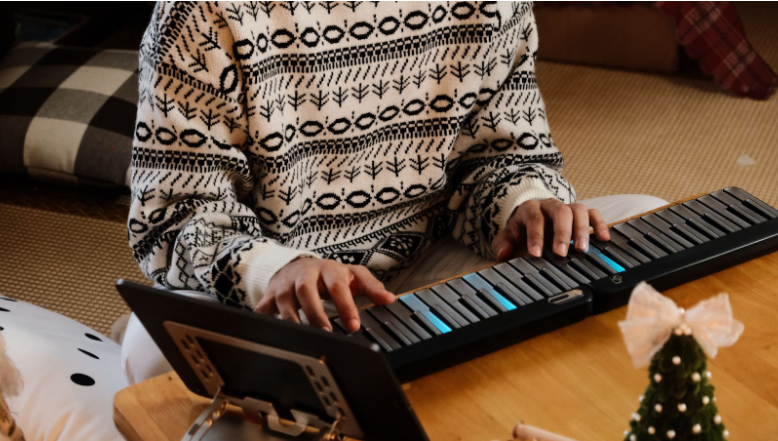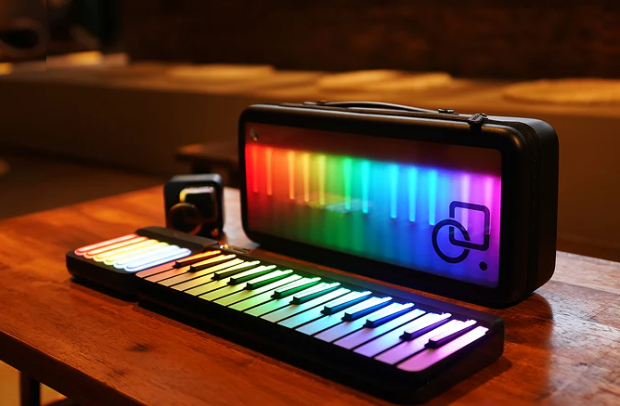
You’ve decided to start making music—fantastic!—but the moment you search for “beginner piano,” two very similar‑looking instruments pop up: the acoustic piano and the digital keyboard. They share rows of black‑and‑white keys, both can fill a room with melody, and to an absolute newbie they might feel interchangeable. Still, the two are not identical. In fact, the difference between piano and keyboard shapes everything from sound and feel to price and portability.
Below is a friendly, no‑jargon guide that breaks it all down. By the end, you’ll know exactly where you stand in the classic keyboard vs piano debate—and which instrument will make you smile every time you sit down to play.
Inside an upright or grand piano, each key is a lever connected to a felt‑covered hammer. Strike the key, the hammer hits a string (or three), and the string vibrates. The vibration resonates through a large wooden soundboard, giving you that lush, room‑filling tone pianists adore. No electricity required—only gravity, precise craftsmanship, and 300 or so taut steel wires.
A keyboard replaces strings with circuitry. Press a key and a micro‑chip triggers a digital recording (“sample”) of an actual piano—or a synth, organ, harpsichord, strings pad, you name it. The result flows through its built‑in speakers or headphones. Because there’s no physical hammer‑string interaction, keyboards can cram hundreds of voices into a slim case. Pretty neat.
Ask any teacher to define piano vs keyboard feel, and you’ll hear one word: weighting. Acoustic pianos use real hammers, so keys fight back slightly and get heavier in the lower register. This “graded” resistance develops finger strength and nuanced control—crucial for classical pieces that demand delicate pianissimo and thunderous fortissimo in the same bar.
Most budget‑to‑midrange keyboards use either semi‑weighted or unweighted (“synth‑action”) keys. They spring back faster and require less force. Easy on young fingers, yes, but your dynamics may feel flatter. Higher‑end stage pianos mimic hammer action astonishingly well, yet they still rely on sensors, not strings.
For pop, rock, and beginner classical pieces, 61 keys are fine. Planning to tackle Rachmaninoff or Debussy? You’ll eventually want the full 88.
If you’re living on a fourth‑floor walk‑up, the difference between keyboard and piano is basically the difference between a feather and a fridge.
Pianos are loud. You can close the lid or use a felt practice rail, but they’ll still resonate through thin walls. Keyboards, on the other hand, offer volume knobs and headphone jacks. Midnight rehearsal without waking the baby? Keyboard wins.
|
Instrument |
Typical Beginner Budget |
Mid‑Level |
High‑End |
|
Acoustic Piano (used) |
$1,500–$4,000 |
$5,000–$15,000 |
$20k+ grands |
|
Digital Piano/Keyboard |
$150–$600 |
$700–$1,500 |
$2,000–$4,000 stage models |
Prices vary with brand, features, and condition. Still, the entry ticket to any acoustic piano dwarfs most keyboards.
These bells and whistles turn a simple keyboard into a production studio. Acoustic pianos offer none of the above—though hybrids with silent or player systems blur the line (and inflate the price).
Many teachers favor acoustic pianos for technique development, especially for classical repertoire. You feel the hammer, earn finger strength, and master pedaling nuances. Yet a responsive, full‑weighted digital keyboard paired with good speakers or headphones can deliver 90 % of that experience at a fraction of the cost—and with metronome, too.
Ultimately, talent grows with consistent, mindful practice. Whether that happens on mahogany or plastic matters less than showing up daily.
If you’re leaning toward a keyboard but want something more future‑proof, consider a high‑quality expansion board like the PopuMusic Expansion Keyboard. It offers:
And it pairs seamlessly with tablets or laptops, letting you dive into recording the day you unbox it. For many beginners, that’s the sweet spot—playability close to an acoustic piano, flexibility only a keyboard can offer.
Not necessarily. If your keyboard has weighted keys and full range, the adaptation is minimal. Semi‑weighted boards build less finger strength, so expect a short adjustment period.
Exam boards often stipulate an acoustic piano or a digital piano that meets specific standards (88 keys, graded hammer action, pedal unit). Check the syllabus; many modern digital pianos qualify.
Entry‑level models use smaller sample banks and speakers, so they can sound thin. Mid‑ to high‑range keyboards employ multi‑layer sampling and better amps, fooling even seasoned ears in a mix.
Acoustic pianos come with three. Keyboards usually ship with one sustain pedal socket; higher models support soft and sostenuto too. For expressive playing, a triple‑pedal unit is a simple add‑on.
Choosing between keyboard vs piano boils down to lifestyle, budget, and musical goals. Love the romance of real wood and vibrating strings, have the room, and can stretch the budget? A piano might be your lifelong companion. Need silent practice, portability, and modern features without taking out a second mortgage? A keyboard—perhaps the flexible PopuMusic model above—will keep your creativity flowing.
And remember: whichever instrument you pick, the magic happens when your fingers show up regularly. That’s when black‑and‑white keys turn into color.
Read more

Best 88-Key Weighted Keyboards for Beginners in 2025: Full Guide + Top Picks
Learning piano on a full‑sized, weighted keyboard feels wonderfully close to an acoustic instrument—you get the same span, the same resistance under your fingertips, and the same “Yes, I’m really d...

Difference Between Digital Piano and Keyboard: What to Know Before You Buy
Shopping for your first set of keys can feel like stepping into a candy store where everything looks delicious—but you only get one pick. Should you go for a fully‑fledged digital piano with all 88...